
Buyers of service vehicles want equipment to perform a series of specified, repeatable service tasks in a particular environment, and they want the equipment to reliably perform those tasks for the duration of its service life with the lowest lifetime cost of ownership.
The Shermac team has a deep understanding of operating in remote areas of Australia, so we can relate to the tough conditions and environment customers deal with on a daily basis. Our engineers and designers seek input from all stakeholders including operators, supervisors and maintenance staff to get a detailed understanding of performance objectives and operating environment.
Once Shermac engineers understand the tasks to be performed and the operating environment, they can specify the operating ‘envelope’ of the vehicle – this is the designed operating capability of a system to perform as intended within defined thresholds, and the rules and constraints to ensure the equipment operates within that envelope.
The intended use of the vehicle will determine the number and type of tanks, the fluid volumes to be carried and the configuration of delivery systems. Operating environment considerations include factors such as terrain – hilly or flat, hard or soft, climate and distance travelled.
Once all the critical operating parameters are understood, the appropriate chassis can be determined. Off-road specifications vary greatly, and one 8 x 4 chassis may have double the carrying capacity of another, and this might be the difference between carrying 50% more fuel and result in significant changes in vehicle uptime and productivity. In addition, items such as roll-over protection, bull bars and tools all add weight that must be considered in load and distribution calculations.
While the design of the vehicle is critical to utilisation, productivity and performance, management must ensure that operating practices adhere absolutely to operations within the asset’s designed operating envelope as this is the single most crucial factor in minimising Total Cost of Ownership (TCO).
This is the critical argument when comparing a standard off-the-shelf service vehicle to a custom-built vehicle. A standard configuration vehicle might be appealing to a buyer if it has a lower initial up-front cost, but the purchase is high-risk as the vehicle might be expected to perform outside of its designed operating envelope and the result will be a much higher TCO due to productivity, maintenance, service and repair overheads. A custom designed product operating within a carefully considered envelope will afford better value for money with maximum productivity and the lowest lifetime cost.
Most buyers will realise significantly lower TCO with a customised vehicle than a standard configuration. Customisation requires an understanding of the specific challenges faced by any customer, a deep-seated intellectual curiosity to look for ways to solve problems and do things better, and concept-to-delivery engineering and manufacturing capabilities. The crucial part of our process is the ability to listen to our customers, build relationships, and design solutions that best suit our clients’ needs and requirements.
Talk to our well-trained and knowledgeable team to find out more about our customisation process and how we can help you.
Call our team on 1300 799 943 or email [email protected] with your inquiry.